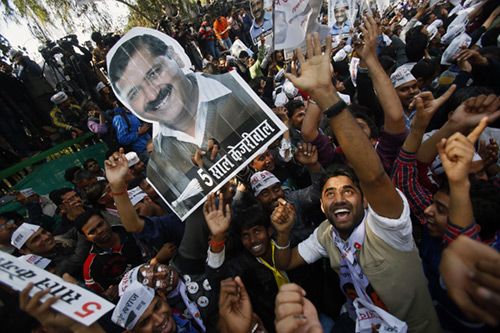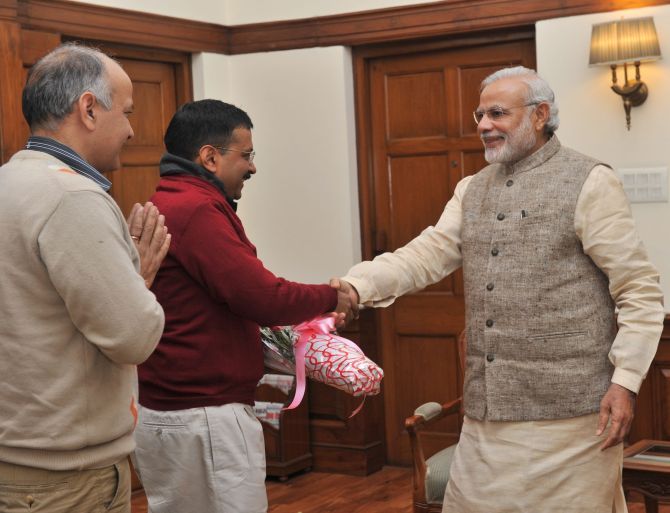'Can the Aam Aadmi Party challenge the BJP? Someday perhaps. But to set him up as a national alternative just now smacks of the very sin that Arvind Kejriwal admits brought him down in 2014 -- arrogance,' says T V R Shenoy.

Can the Aam Aadmi Party create a pan-India front confronting Narendra Modi?
No. Not at any rate in the next five to ten years. And there are two reasons for believing so, the first being political, the second dealing with economic-administrative issues.
The political obstacle revolves around the Aam Aadmi Party's ideology, or rather its lack of any ideology. Ask anyone in the party, and the standard response is that the party stands foursquare against corruption.
This is childish; which party says it openly espouses corruption?
To which Aam Aadmi Party supporters piously intone: 'All of them are corrupt!'
Building an all-India front requires the Aam Aadmi Party to reach out to allies. But it gets nowhere if it starts with the premise that everyone except the Aam Aadmi Party is sullied.
The Aam Aadmi Party's phoenix act in Delhi came courtesy of the collapse of the non-BJP parties.
In the Vidhan Sabha elections of December 2013 the Congress polled 24.55% of the votes and the Bahujan Samaj Party got 5.35%.
By the Lok Sabha polls of 2014 the Congress had fallen to 15.22% and the Bahujan Samaj Party to 1.23% in Delhi.
In February 2015 the Congress slumped to 9.7% of the votes, the Bahujan Samaj Party remaining more or less where it had been. Other national parties have no presence to speak of in the capital.
The votes lost by the Congress and the Bahujan Samaj Party went to the Aam Aadmi Party. But in how many other states is there such a collapse of non-BJP parties?
An obvious answer is Delhi's neighbouring state of Haryana.
In 2005 the Congress had 67 seats (in a 90-strong assembly) and 42.46% of the votes. In 2009 that fell to 40 seats and 35.08% of the votes, but the Congress still formed the ministry.
In 2014 the Congress won just 15 seats and 20.58% of the votes.
Just as in Delhi, the Congress was pushed to third position, behind both the BJP and Om Parkash Chautala's Lok Dal. Given the tainted image of both the Congress and the Lok Dal -- Chautala is currently in jail for corruption --- the Aam Aadmi Party can mop up votes from both.
Adjoining Haryana is Punjab, the state that gave the Aam Aadmi Party the only four MPs that it has. In the last general election the Aam Aadmi Party contested 432 seats, and lost its deposit in 413 of those. Punjab was the saving grace for the party.
But there is no election in Haryana before 2019, and the Vidhan Sabha elections in Punjab are set for 2017.
The next state going to the polls, later this year, is Bihar.
Nitish Kumar would be the ideal alliance partner for the Aam Aadmi Party. He has no scams against his name and he gave Bihar a fairly good government between 2005 and 2014. But this is where the Aam Aadmi Party's holier-than-thou politics works against it.
In 2014 Nitish Kumar's Janata Dal-United garnered 16.04% of the votes and two of the 40 Lok Sabha constituencies. Lalu Prasad Yadav's Rashtriya Janata Dal got 20.46% of the votes and four seats. The Congress got 8.56% of the votes and two seats.
Against this divided opposition, the BJP won 22 seats on its own, and the BJP's coalition partners scooped up the rest.
The lesson -- hang together, or hang separately -- was clear. Nitish Kumar and Lalu Prasad Yadav buried their differences, bringing the Congress into the alliance for good measure.
The Aam Aadmi Party can take Nitish Kumar as a partner, but it simply cannot be seen alongside Lalu Prasad Yadav and the Congress.
This scenario is going to be repeated over and over again in other states. Neither the Samajwadi Party nor the Bahujan Samaj Party is acceptable to the Aam Aadmi Party in Uttar Pradesh; neither the CPI-M nor the Trinamool Congress is attractive in West Bengal; neither the DMK nor the AIADMK is available in Tamil Nadu. In the immediate future, the Aam Aadmi Party's best hope is to rule Delhi so well that it becomes vote-catcher elsewhere, particularly in urban areas like Mumbai or Bengaluru.
In the immediate future, the Aam Aadmi Party's best hope is to rule Delhi so well that it becomes vote-catcher elsewhere, particularly in urban areas like Mumbai or Bengaluru.
But can it govern effectively? Here is the second hurdle, the economic-administrative problems.
At the heart of the Aam Aadmi Party manifesto lie its promises to slash Delhiites' electricity bills by half and to supply 700 free litres of water to every household every day.
It has promised other goodies -- free wi-fi for Internet users, lower VAT rates for traders, more schools and colleges and hospitals -- but electricity and water are the core issues.
Since 2012 the Aam Aadmi Party has claimed Delhi's three private distributors have been 'goldplating' expenses, and that electricity rates can be brought down by cutting down on 'excessive' profits.
On January 21, 2015 the party released a white paper (external link) that was ignored because of the media frenzy after the BJP made Kiran Bedi its chief ministerial candidate. Eschewing rhetoric, it strikes a more sober note:
'Central PSU National Thermal Power Corporation, which have (sic) coal linkages with Coal India and which supplies about 75 percent of Delhi's total power consumption, sells power at rates between as low as Rs 1.75 per unit to as high as Rs 6.15 per unit.'
'The monopoly of Coal India has made it one of the most inefficient but ironically one of the most profitable and cash rich PSUs.'
'Ways and means have to found to encourage distribution companies to purchase power from economical sources and wriggle out of expensive and unsustainable Power Purchase Agreements.'
To recap: Delhi gets 75 per cent of its electricity from the NTPC (National Thermal Power Corporation). NTPC sells at high rates because Coal India can't offer cheap coal; the private distributors must 'wriggle out' of these contracts. What happens if they can't?
The white paper also says that 'it is imperative that Govt of NCT of Delhi sets up power generation plants either by itself or in collaboration with other players at most economical rates and locations.'
Coal-burning plants in Delhi would never get environmental approval. A nuclear plant within a hundred kilometres of the capital is a security nightmare. Does the Kejriwal ministry want to set up hydel plants in Himachal Pradesh or Uttarakhand, or a thermal plant in coal-rich Jharkhand?
Once built -- assuming they are built -- what stops those states from claiming the electricity for their own purposes?
When the Kudankulam nuclear plant was planned the idea was to supply power to Kerala, Karnataka and Puducherry too, but Tamil Nadu now says it needs all the electricity.
The Aam Aadmi Party also released a white paper (external link) on Delhi's water woes on January 27, 2015. Here, the only substantial suggestion is that Haryana will be made to supply water through the Munak Canal.
Look at the map: The Yamuna is as much the lifeline of Haryana as of Delhi. Haryana says it cannot provide more unless compensated with water from Punjab through the Sutlej-Yamuna Link, or perhaps from Uttarakhand or Himachal Pradesh. Even mentioning the Sutlej-Yamuna Link is guaranteed to raise tempers in Punjab.
Briefly, fulfilling the Aam Aadmi Party's promise of free water to Delhiites risks angering Haryana and Punjab -- precisely the two states where the party can expand.
Many believe that 'compromise' is a dirty word. True leaders know that it is the only way to get things done. Becoming a national alternative means that the Aam Aadmi Party may be asked to compromise its stance of 'everybody is corrupt but us.'
Providing good governance requires the Kejriwal ministry to compromise on its promises on electricity and water -- or risk bankruptcy.
Can the Aam Aadmi Party challenge the BJP? Someday perhaps, but to set him up as a national alternative just now smacks of the very sin that Arvind Kejriwal admits brought him down in 2014 -- arrogance.
Images: Top: Aam Aadmi Party supporters with portraits of Delhi Chief Minister Arvind Kejriwal as they celebrate victory outside the AAP office in New Delhi. Photograph: Anindito Mukherjee/Reuters
Bottom: Arvind Kejriwal and Manish Sisodia greet Prime Minister Narendra Modi. Photograph: Press Information Bureau










